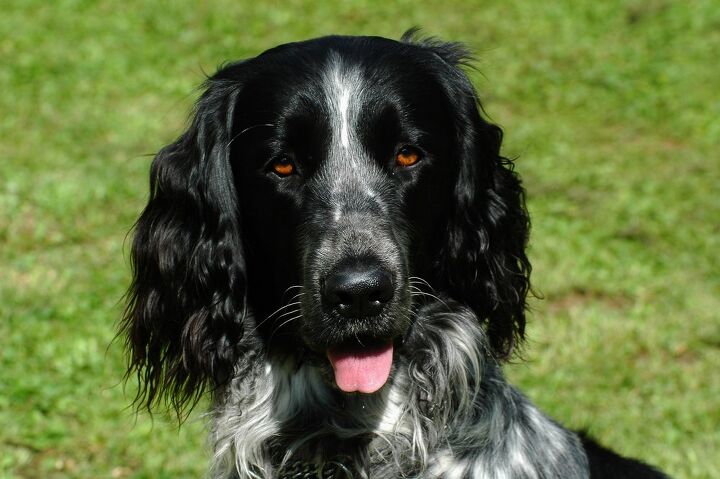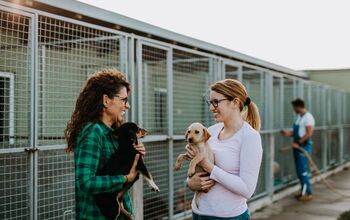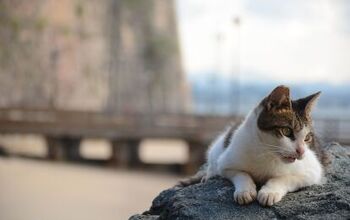Large Münsterländer


About Large Münsterländer
Though the name may be a little strange, the Large Münsterländer is a wonderful and beautiful breed. With medium-length, silky fur this dog exhibits a unique black- or brown-and-white coloration with spots and patches that sets it apart. Not only is this breed a sight to behold, but he is a talented gun dog and gentle with children as well. Consider the Large Münsterländer for your next family pet!
Though the name may be a little strange, the Large Münsterländer is a wonderful and beautiful breed.
The Large Münsterländer is a fairly new breed, having only been recognized in 1919. This breed originated in the German town of Munster sometime during the early 20th century, though his predecessors may have been around during the Middle Ages. Developed from the German Longhaired Pointer and various Spaniels, the Large Münsterländer was popular throughout Europe until the Great Depression and World War II nearly decimated the breed. The breed first arrived in America in 1966 where its development has been overseen by the Large Münsterländer Club of North America. The breed is not yet recognized by the AKC but was recognized by the United Kennel Club in 2006.
The Large Münsterländer was developed from the German Longhaired Pointer and various Spaniels.
As a large-breed dog, the Large Münsterländer should be fed a high-quality dry food formulated for large dogs. You should also consider, however, the fact that this is a highly active hunting breed – an active breed or working formula may also be a good choice.
Though the Large Münsterländer is calm and gentle with children, his primary purpose is hunting.
Though the Large Münsterländer is calm and gentle with children, his primary purpose is hunting. The breed was developed for his tracking, pointing, and retrieving instincts, though he still requires training. This breed is very smart and highly trainable, though he should be handled gently with positive reinforcement training techniques. The Large Münsterländer does have a tendency to bark and can become destructive when left alone for too long, so you may need to do some extra training to curb these tendencies. Early socialization is recommended as well, especially if you plan to keep him in a home with other pets. Keep in mind, however, that his instincts are to chase and even attack small animals, so be careful around cats and other non-canine pets.
The Large Münsterländer is a large-breed dog, standing between 23 and 25.5 inches tall and weighing between 50 and 70 pounds at maturity.
The Large Münsterländer has a gentle demeanor, though he does have a tendency to become high-strung and destructive without adequate exercise. These dogs have a natural instinct to retrieve and carry things in their mouth – they may also chase and attack smaller animals, particularly rodents. In terms of temperament, the Large Münsterländer is typically cheerful, intelligent, and obedient though they can be a little sensitive to harsh training methods. These dogs do require a firm and consistent hand in training, though they are fairly easy to handle. This breed also tends to mature slowly, so be prepared to deal with some puppy-like tendencies for over a year.
The Large Münsterländer is a healthy breed in general, though all dogs are prone to certain health problems. Some of the conditions known to affect the breed include hip dysplasia, cataracts, and osteochondrosis. The breed may also be prone to ear infections and field injuries.
The average lifespan for the Large Münsterländer is thought to be about 11 to 13 years which is about average for a breed of its size. To maximize your dog’s lifespan, be sure to feed him a healthy, high-quality diet formulated for large-breed dogs or a formula for active breeds.
As a hunting dog, the Large Münsterländer has very high exercise requirements – this breed is also very prone to hyperactivity if his daily needs are not met. These dogs need at least an hour of vigorous exercise each day and will appreciate having a fenced yard in which to run and play as well.
The Large Münsterländer has a gentle demeanor.
The Large Münsterländer is not currently recognized by the AKC but he is recognized by the FCI and the United Kennel Club. The FCI classifies him in Group 7 as a Continental Pointing Dog and the United Kennel Club recognizes him as a Gun Dog.
The Large Münsterländer’s coat is one of his most recognizable characteristics – it is medium-length and highly variable in terms of pattern. The breed exhibits a wide range of black- or brown-and-white patterns with solid areas, patches, ticking, and spots due to the piebald gene which is common in the breed. In most dogs, the head is predominantly black/brown and the tip of the tail white. The coat is very dense but firm and sleek. It should be brushed daily to keep it soft and to reduce shedding.
The average litter size for the Large Münsterländer is 5 to 10 puppies. Because this breed grows fairly large, it is important to keep puppies from growing too fast – overgrowth could result in an increased risk for musculoskeletal issues in adulthood. Feed your puppy a large-breed puppy formula until he reaches 80% of his maximum size then switch to a large-breed adult formula. You should also start your Large Münsterländer with socialization and training as early as possible.
Photo credits: Lenkadan/Shutterstock; anetapics/Shutterstock; Bildagentur Zoonar GmbH/Shutterstock

Kate Barrington is the loving owner of two cats (Bagel and Munchkin) and a noisy herd of guinea pigs. Having grown up with golden retrievers, Kate has a great deal of experience with dogs but labels herself a lover of all pets. Having received a Bachelor's degree in English, Kate has combined her love for pets and her passion for writing to create her own freelance writing business, specializing in the pet niche.
More by Kate Barrington

























